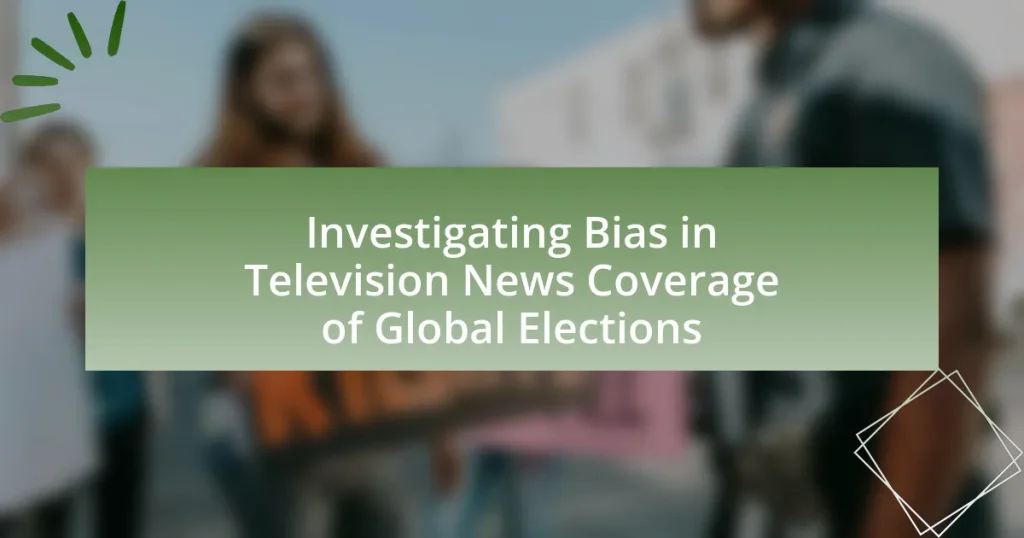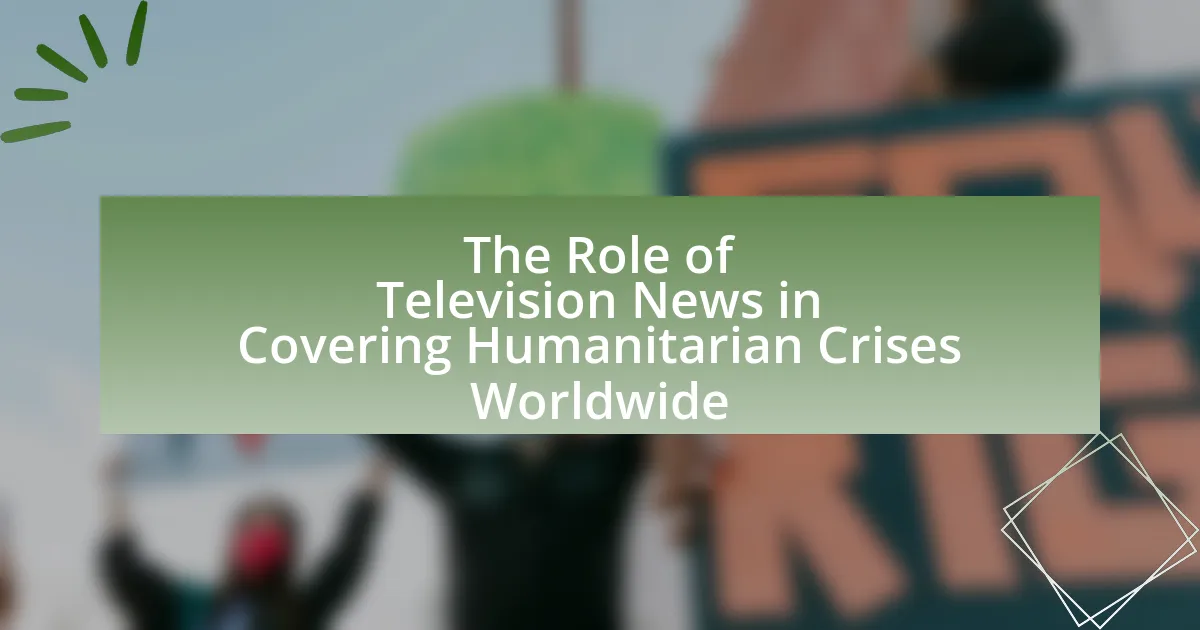Investigating bias in television news coverage of global elections involves analyzing how news outlets may favor specific political parties, candidates, or ideologies, impacting public perception and voter behavior. The article examines the importance of scrutinizing media bias, its potential effects on electoral outcomes, and the methodologies used to identify such biases, including content analysis and comparative studies. Key concepts such as selection bias, framing, and agenda-setting are discussed, along with the implications of biased reporting on democracy and voter engagement. Additionally, the article outlines strategies for mitigating bias in news coverage and emphasizes the role of audiences in promoting accountability and transparency in journalism.
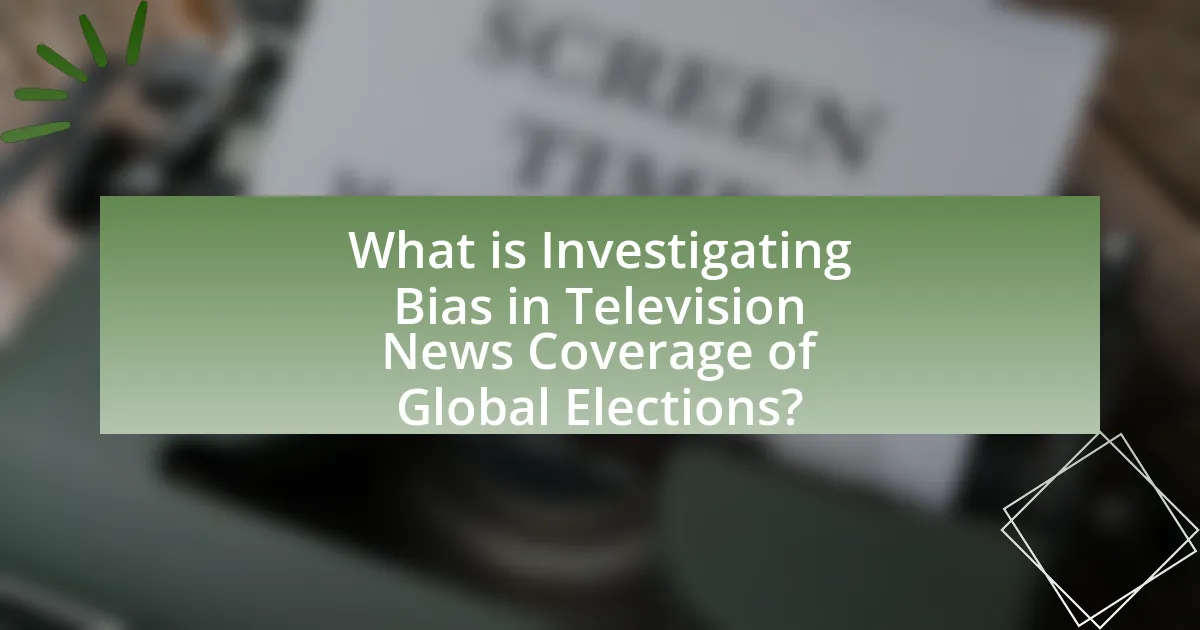
What is Investigating Bias in Television News Coverage of Global Elections?
Investigating bias in television news coverage of global elections involves analyzing how news outlets may favor certain political parties, candidates, or ideologies in their reporting. This investigation typically examines the selection of stories, framing of issues, and language used, which can influence public perception and voter behavior. Research has shown that media bias can significantly affect electoral outcomes; for instance, a study by the Pew Research Center found that partisan news coverage can lead to polarized audiences, impacting their voting decisions.
Why is it important to investigate bias in television news coverage?
Investigating bias in television news coverage is crucial because it directly impacts public perception and understanding of events, particularly during global elections. Bias can shape narratives, influence voter behavior, and ultimately affect democratic processes. For instance, studies have shown that biased reporting can lead to misinformation, which can sway public opinion and alter election outcomes. An analysis by the Pew Research Center found that 62% of Americans believe news organizations favor one side in their reporting, highlighting the need for scrutiny to ensure fair and balanced coverage.
What are the potential impacts of biased news coverage on public perception?
Biased news coverage can significantly distort public perception by shaping opinions and beliefs based on selective information. When news outlets present information in a biased manner, they can influence audience attitudes towards political candidates, policies, or events, often leading to polarization. For instance, a study by the Pew Research Center found that individuals exposed to partisan news sources are more likely to hold extreme views and exhibit confirmation bias, reinforcing their pre-existing beliefs. This selective exposure can create echo chambers, where individuals only engage with information that aligns with their biases, further entrenching divisions within society.
How does bias in news coverage influence electoral outcomes?
Bias in news coverage significantly influences electoral outcomes by shaping public perception and voter behavior. When media outlets favor specific candidates or parties, they can create a narrative that highlights positive attributes of their preferred choice while downplaying or criticizing opponents. For instance, studies have shown that biased reporting can lead to increased support for favored candidates; a 2016 study by the Pew Research Center found that 62% of Americans believed that news organizations favor one side over another, which can sway undecided voters. Furthermore, biased coverage can affect voter turnout, as negative portrayals of candidates may discourage supporters from voting. Thus, the impact of bias in news coverage is evident in its ability to alter public opinion and ultimately influence the results of elections.
What are the key concepts related to bias in news coverage?
Key concepts related to bias in news coverage include selection bias, framing, and agenda-setting. Selection bias occurs when certain stories or perspectives are chosen over others, influencing public perception by highlighting specific issues while ignoring others. Framing refers to the way information is presented, which can shape audience interpretation and emotional response; for example, portraying a political candidate positively or negatively can significantly affect voter opinion. Agenda-setting involves the media’s ability to prioritize certain topics, thereby influencing what audiences perceive as important. Research by McCombs and Shaw in 1972 demonstrated that media coverage can shape public agenda, illustrating the powerful role of bias in news reporting.
What types of bias can be identified in television news reporting?
Television news reporting can exhibit several types of bias, including selection bias, framing bias, and confirmation bias. Selection bias occurs when certain stories or viewpoints are chosen over others, leading to an incomplete representation of events. For instance, during global elections, networks may focus on particular candidates or issues that align with their editorial stance, thereby influencing public perception. Framing bias involves presenting information in a way that emphasizes certain aspects while downplaying others, which can shape audience interpretation. An example is how different networks might highlight economic issues versus social issues during election coverage. Confirmation bias manifests when news outlets favor information that supports their existing beliefs or narratives, often ignoring contradictory evidence. This can be seen in how some channels report on election polls, selectively presenting data that aligns with their political leanings. These biases can significantly affect the audience’s understanding of electoral processes and outcomes.
How do framing and agenda-setting contribute to bias?
Framing and agenda-setting contribute to bias by influencing how information is presented and prioritized in media coverage. Framing shapes the interpretation of events by emphasizing certain aspects while downplaying others, which can lead audiences to adopt specific viewpoints. For example, a news outlet may frame an election as a battle between good and evil, thus biasing public perception against one candidate. Agenda-setting, on the other hand, determines which issues are deemed important and worthy of attention, effectively guiding public discourse. Research by McCombs and Shaw in 1972 demonstrated that the issues highlighted by media directly correlate with what audiences perceive as significant, thereby reinforcing biases toward those topics. Together, these processes create a skewed representation of reality, affecting public opinion and understanding of global elections.
What methodologies are used in investigating bias in news coverage?
Content analysis is a primary methodology used in investigating bias in news coverage. This approach systematically evaluates news articles or broadcasts to identify patterns in language, framing, and representation. For instance, researchers may analyze the frequency of certain terms or the prominence given to specific viewpoints, allowing for quantifiable assessments of bias. Additionally, comparative analysis is employed, where coverage from different news outlets is juxtaposed to highlight discrepancies in reporting. Studies, such as those conducted by the Pew Research Center, have shown that varying editorial slants can significantly influence public perception during elections, reinforcing the validity of these methodologies.
What qualitative and quantitative methods are commonly employed?
Qualitative methods commonly employed in investigating bias in television news coverage include content analysis, interviews, and focus groups. Content analysis allows researchers to systematically evaluate the presence of bias in news narratives by examining language, themes, and framing. Interviews and focus groups provide insights into audience perceptions and interpretations of news coverage, revealing subjective experiences and opinions.
Quantitative methods often utilized include surveys, statistical analysis, and experiments. Surveys can quantify audience attitudes towards perceived bias in news coverage, while statistical analysis can assess correlations between news framing and public opinion. Experiments may involve manipulating news content to measure its impact on viewer perceptions, providing empirical evidence of bias effects. These methods collectively enhance understanding of bias in television news coverage during global elections.
How can content analysis reveal bias in television news?
Content analysis can reveal bias in television news by systematically examining the language, framing, and representation of different subjects within news coverage. This method allows researchers to quantify the frequency of specific themes, the tone of reporting, and the prominence given to various viewpoints. For instance, a study analyzing coverage of the 2020 U.S. presidential election found that certain networks disproportionately featured negative narratives about one candidate while favoring positive coverage of another, indicating a clear bias in reporting. By employing content analysis, researchers can identify patterns that suggest partiality, such as the selective use of sources or the framing of issues in a way that aligns with particular political agendas.
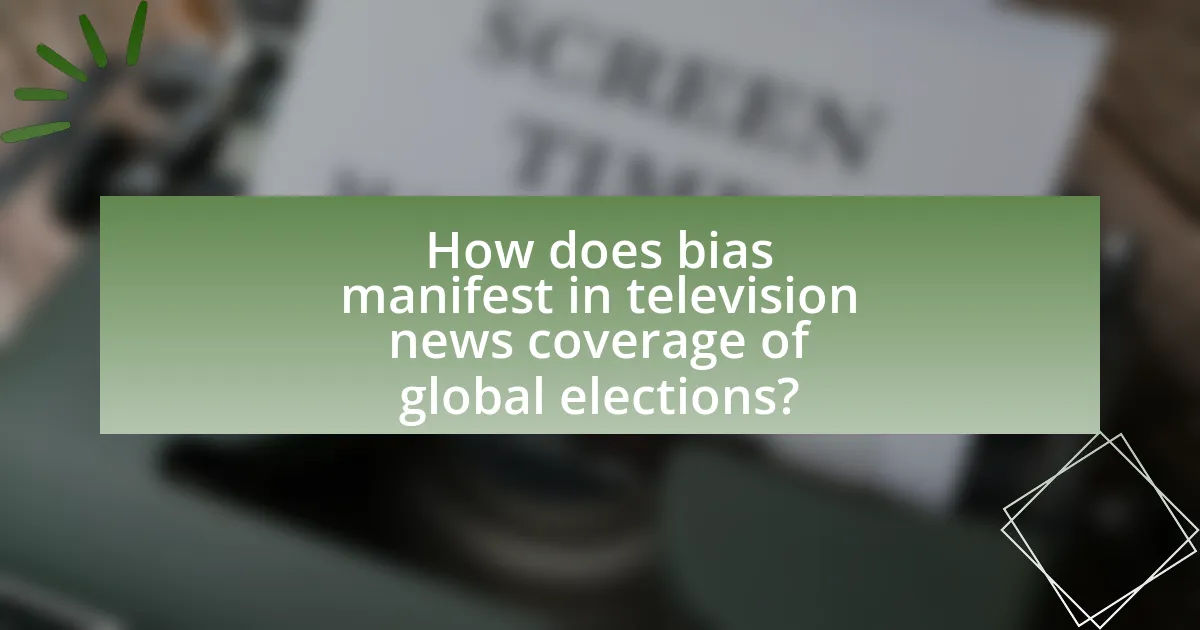
How does bias manifest in television news coverage of global elections?
Bias in television news coverage of global elections manifests through selective reporting, framing, and the portrayal of candidates. Selective reporting occurs when certain events or statements are highlighted while others are downplayed or ignored, influencing public perception. For instance, a study by the Pew Research Center found that coverage of the 2016 U.S. presidential election favored certain candidates based on the amount of airtime dedicated to them, which skewed viewer understanding of their platforms. Framing involves presenting information in a way that emphasizes particular aspects over others, shaping how audiences interpret the news. For example, labeling a protest as a “riot” versus a “demonstration” can evoke different emotional responses. Additionally, the portrayal of candidates often reflects bias through the use of language, imagery, and tone, which can either humanize or demonize individuals based on the network’s political leanings. This combination of selective reporting, framing, and portrayal creates a biased narrative that can significantly influence voter opinions and behaviors during global elections.
What are the common indicators of bias in election coverage?
Common indicators of bias in election coverage include the selection of stories, framing of issues, and the tone of reporting. For instance, media outlets may favor certain candidates by providing more airtime or positive coverage, while downplaying or criticizing opponents. Research shows that the language used can also reflect bias; for example, using emotionally charged words to describe one candidate while employing neutral language for another can skew public perception. Additionally, the omission of key facts or perspectives can indicate bias, as seen in studies where certain demographic viewpoints are underrepresented in coverage, leading to a distorted narrative of the electoral process.
How does the choice of language affect the perception of bias?
The choice of language significantly influences the perception of bias by framing information in ways that can evoke specific emotional responses or interpretations. For instance, the use of loaded language, such as “terrorist” versus “freedom fighter,” can lead audiences to perceive events or individuals in a biased manner, shaping their opinions based on the connotations of the words used. Research by the American Psychological Association indicates that language can activate different cognitive pathways, affecting how information is processed and understood. This demonstrates that the linguistic choices made in television news coverage can either reinforce or challenge existing biases among viewers, ultimately impacting their understanding of global elections.
What role does the selection of sources play in biased reporting?
The selection of sources plays a critical role in biased reporting by influencing the narrative and framing of news stories. When journalists choose sources that align with specific viewpoints or agendas, they can create a skewed representation of events, leading to partiality in coverage. For instance, a study by the Pew Research Center found that news outlets often favor sources that reinforce their editorial stance, which can result in a lack of diverse perspectives and an imbalanced portrayal of issues. This selective sourcing can perpetuate stereotypes and misinform the audience, ultimately shaping public perception in a biased manner.
How do different countries exhibit bias in their election coverage?
Different countries exhibit bias in their election coverage through selective reporting, framing of issues, and the portrayal of candidates. For instance, in the United States, major networks often favor particular political parties, leading to skewed narratives that emphasize certain viewpoints while downplaying others. In Russia, state-controlled media predominantly supports the ruling party, presenting a one-sided perspective that marginalizes opposition voices. In contrast, countries like Sweden demonstrate a more balanced approach, adhering to journalistic standards that promote impartiality. Research by the Pew Research Center indicates that media bias can significantly influence public perception and voter behavior, highlighting the critical role of media in shaping electoral outcomes.
What are the differences in bias between developed and developing nations?
Developed nations typically exhibit a bias towards portraying their political systems as superior, often emphasizing stability and democratic values, while developing nations may be depicted as unstable or corrupt, focusing on conflict and governance issues. This difference in bias can be attributed to the media’s framing practices, where developed nations are often seen through a lens of success and progress, supported by historical contexts such as economic stability and established democratic institutions. In contrast, developing nations are frequently framed in terms of challenges and crises, influenced by factors like limited resources and political turmoil, which can lead to a skewed representation in television news coverage. For instance, a study by the Pew Research Center found that news coverage from developed countries often highlights positive aspects of governance, whereas coverage from developing nations tends to focus on negative events, reinforcing stereotypes and biases.
How do cultural factors influence bias in news reporting?
Cultural factors significantly influence bias in news reporting by shaping the perspectives and narratives that journalists prioritize. For instance, cultural norms and values dictate what is considered newsworthy, often leading to selective coverage that aligns with the dominant cultural viewpoint. Research indicates that media outlets in different countries exhibit varying biases based on cultural contexts; for example, a study by Hallin and Mancini in “Comparing Media Systems” highlights how Western media often emphasizes individualism, while collectivist cultures may focus on community-oriented narratives. This cultural lens can result in the portrayal of events in a manner that reflects specific societal beliefs, ultimately affecting public perception and understanding of global issues.
What are the consequences of biased television news coverage during elections?
Biased television news coverage during elections can significantly distort public perception and influence voter behavior. This distortion occurs as biased reporting often favors specific candidates or parties, leading to an unbalanced representation of issues and viewpoints. For instance, a study by the Pew Research Center found that 62% of Americans believe news organizations favor one side when reporting on political issues, which can result in voters making decisions based on incomplete or skewed information. Consequently, this can undermine the democratic process by creating an electorate that is misinformed or polarized, ultimately affecting election outcomes and public trust in media institutions.
How does biased coverage affect voter turnout and engagement?
Biased coverage negatively affects voter turnout and engagement by creating a distorted perception of candidates and issues. When media outlets favor certain political perspectives, they can lead to misinformation and disenfranchisement among voters who feel their views are underrepresented. Research indicates that voters exposed to biased news are less likely to participate in elections; for example, a study by the Pew Research Center found that individuals who perceive media bias are more likely to disengage from the electoral process. This disengagement can result in lower voter turnout, as individuals may feel their votes do not matter in a skewed political landscape.
What are the long-term effects of biased reporting on democracy?
Biased reporting has detrimental long-term effects on democracy by undermining informed citizen participation and eroding public trust in media institutions. When news coverage favors specific political agendas or perspectives, it skews public perception and limits access to diverse viewpoints, which is essential for a functioning democracy. Research indicates that consistent exposure to biased media can lead to polarization among the electorate, as individuals become entrenched in their beliefs and less open to opposing views. For instance, a study by the Pew Research Center found that partisan news consumption correlates with increased political division, demonstrating how biased reporting can create echo chambers that hinder constructive political discourse. This erosion of trust in media can also result in decreased voter engagement and lower electoral participation, as citizens may feel disillusioned or misinformed about the political process.
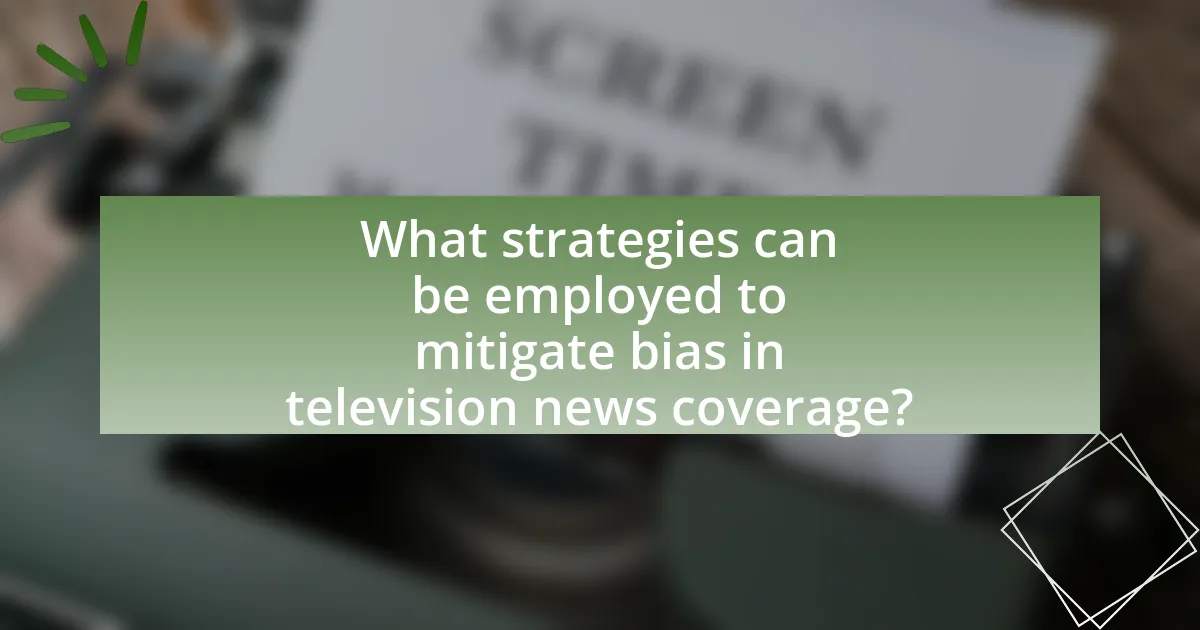
What strategies can be employed to mitigate bias in television news coverage?
To mitigate bias in television news coverage, news organizations can implement strategies such as employing diverse editorial teams, utilizing fact-checking protocols, and adhering to transparent reporting standards. Diverse editorial teams bring varied perspectives, which can reduce the likelihood of a singular narrative dominating coverage. For instance, research from the American Press Institute indicates that diversity in newsrooms leads to more comprehensive reporting. Fact-checking protocols help ensure accuracy and objectivity, as seen in organizations like PolitiFact, which systematically verify claims made in news stories. Additionally, transparent reporting standards, such as disclosing sources and methodologies, foster trust and accountability, as highlighted by the Trust Project, which emphasizes the importance of transparency in journalism.
How can journalists ensure balanced reporting during elections?
Journalists can ensure balanced reporting during elections by adhering to principles of impartiality and fairness in their coverage. This involves presenting diverse viewpoints, fact-checking claims made by candidates, and providing equal airtime to all parties involved. Research indicates that balanced reporting can enhance public trust in media; for instance, a study by the Pew Research Center found that 62% of Americans believe that balanced news coverage is essential for a healthy democracy. By actively seeking out underrepresented voices and avoiding sensationalism, journalists can contribute to a more informed electorate.
What best practices should journalists follow to minimize bias?
Journalists should adhere to several best practices to minimize bias, including employing fact-checking, presenting multiple viewpoints, and maintaining transparency about sources. Fact-checking ensures that information is accurate and reliable, which is crucial in reporting on global elections where misinformation can skew public perception. Presenting multiple viewpoints allows for a balanced representation of differing opinions, fostering a more comprehensive understanding of the issues at hand. Maintaining transparency about sources helps audiences assess the credibility of the information presented, thereby reducing the potential for bias. These practices are supported by research indicating that balanced reporting enhances audience trust and understanding, as demonstrated in studies by the Pew Research Center on media credibility.
How can media organizations promote transparency and accountability?
Media organizations can promote transparency and accountability by implementing rigorous fact-checking processes and openly disclosing their sources and funding. By establishing independent editorial standards and regularly publishing corrections, media outlets can enhance their credibility and foster trust among audiences. For instance, organizations like ProPublica and the Associated Press have adopted transparency initiatives that include detailed disclosures about their funding sources and methodologies, which helps to mitigate biases and conflicts of interest. Furthermore, engaging with audiences through feedback mechanisms and public forums allows media organizations to address concerns and improve their reporting practices, thereby reinforcing their commitment to accountability.
What role do audiences play in addressing bias in news coverage?
Audiences play a critical role in addressing bias in news coverage by actively engaging with media content and holding news organizations accountable. When audiences critically analyze news reports, they can identify instances of bias and demand more balanced reporting. Research indicates that audience feedback, such as complaints and social media interactions, can influence editorial decisions and prompt news outlets to reconsider their coverage strategies. For example, studies have shown that public outcry over biased reporting can lead to changes in how news is presented, as seen in various instances where media outlets adjusted their narratives following audience criticism. This dynamic illustrates the power of audience engagement in promoting fairness and accuracy in news coverage.
How can viewers critically evaluate news sources for bias?
Viewers can critically evaluate news sources for bias by analyzing the language, framing, and sourcing of the information presented. Language that is emotionally charged or loaded can indicate bias, as it may aim to provoke a specific reaction rather than inform. Framing refers to how a story is presented, including which aspects are emphasized or downplayed, which can shape public perception. Additionally, examining the sources cited in a news report is crucial; reliance on a narrow range of sources or lack of expert opinions can suggest a biased perspective. Research by the Pew Research Center shows that audiences often perceive bias based on the political alignment of the news outlet, highlighting the importance of cross-referencing multiple sources to gain a balanced view.
What tools are available for audiences to identify biased reporting?
Audiences can utilize several tools to identify biased reporting, including media bias charts, fact-checking websites, and bias detection software. Media bias charts, such as those created by Ad Fontes Media, visually represent the political leanings of various news outlets, helping audiences discern potential bias in reporting. Fact-checking websites like Snopes and FactCheck.org evaluate the accuracy of claims made in news stories, providing context and verification. Additionally, bias detection software, such as Media Bias/Fact Check, analyzes language and content to assess bias levels in articles. These tools collectively empower audiences to critically evaluate news coverage and recognize bias in television news related to global elections.
What are the best practices for consumers of news to combat bias?
To combat bias in news consumption, consumers should actively seek diverse sources of information. Engaging with a variety of news outlets, including those with differing political perspectives, helps to create a more balanced understanding of events. Research indicates that individuals who consume news from multiple sources are less likely to hold biased views, as they are exposed to a wider range of opinions and facts. Additionally, fact-checking claims through reputable organizations can further mitigate the influence of biased reporting. Studies show that fact-checking can significantly reduce the spread of misinformation, reinforcing the importance of verifying information before accepting it as truth.
How can individuals diversify their news consumption to reduce bias?
Individuals can diversify their news consumption to reduce bias by actively seeking information from a variety of sources, including different media outlets, international news organizations, and independent journalism platforms. This approach allows individuals to encounter multiple perspectives on the same issue, which can counteract the influence of any single source’s bias. Research indicates that consuming news from diverse sources can lead to a more balanced understanding of events; for instance, a study by the Pew Research Center found that people who engage with a range of news outlets are more likely to recognize the complexity of issues and less likely to hold polarized views. Additionally, incorporating news from various political orientations and formats, such as podcasts, print media, and online articles, further enhances exposure to differing viewpoints, thereby fostering critical thinking and informed decision-making.
What steps can be taken to engage in informed discussions about bias in news coverage?
To engage in informed discussions about bias in news coverage, individuals should first educate themselves on media literacy, which involves understanding how news is produced and the potential influences on reporting. This foundational knowledge enables participants to critically analyze news sources and identify biases.
Next, individuals should compare multiple news outlets to observe differing perspectives on the same events, which can highlight biases in coverage. Engaging in discussions with diverse groups can also provide varied viewpoints, fostering a more comprehensive understanding of the issues at hand.
Additionally, utilizing fact-checking resources, such as Snopes or FactCheck.org, can help verify claims made in news reports, ensuring that discussions are based on accurate information. Research indicates that media literacy education significantly improves individuals’ ability to recognize bias, as shown in studies conducted by the American Psychological Association, which found that informed individuals are better equipped to discern biased reporting.
By following these steps, participants can contribute to more informed and constructive discussions about bias in news coverage.
